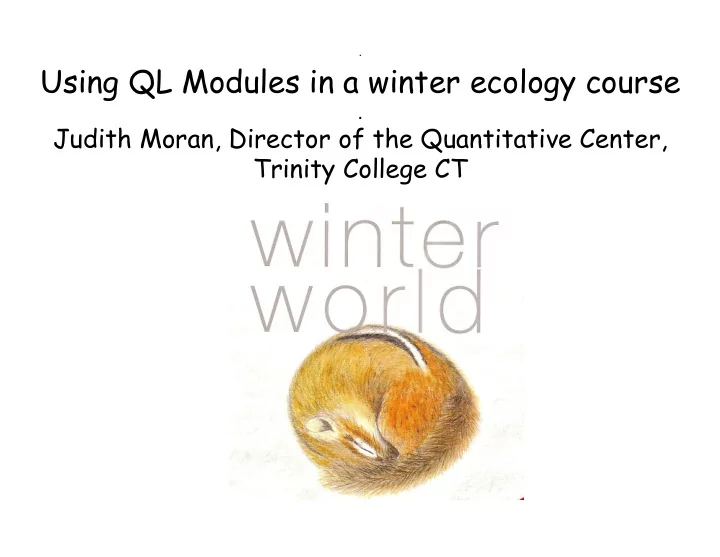

. Using QL Modules in a winter ecology course . Judith Moran, Director of the Quantitative Center, Trinity College CT
Scott Smedley Trinity Biology Department . Early in the course we will consider how nearby microhabitats within a field site can represent very different thermal environments, having major implications for the organisms that inhabit them. After our discussion of these concepts in class, students will go to a field site where they will select two adjacent microhabitats and hypothesize whether or not they differ thermally (and if so, how they differ). They will then plant temperature loggers in the microhabitats to record the temperature hourly over much of the winter. Later the students will return to the site and retrieve the loggers, download the data, and use the datasets as evidence to support or refute their hypothesis.
Can you spot the Thermal Logger?
Problem: Scott’s expectations of the students’ quantitative abilities was too high! They had trouble both interpreting and depicting the data they collected.
Solution: . Three modules to address the specific quantitative skills his students need. In the modules, students will work on smaller data sets from the bald eagle sightings at Shepaug Dam on the Connecticut River. Excel Module . Students will learn how to manage data sets in a spread sheet and create effective graphical displays from large data sets.
Graphical Module: Students will learn how to create and interpret graphical displays of their data including: . 1) histograms 2) multiple line graphs (they will eventually be graphing temperature as a function of time for two of the loggers on the same set of axes). 3) column graph with error bars Goal: Students will be able to determine the most effective way of displaying their data.
Pond Temperature from 31 January to 11 April 2005 40 30 Temperature (Degrees Celcius) 20 10 0 1/28/05 2/7/05 2/17/05 2/27/05 3/9/05 3/19/05 3/29/05 4/8/05 4/18/05 12:00 AM 12:00 AM 12:00 AM 12:00 AM 12:00 AM 12:00 AM 12:00 AM 12:00 AM 12:00 AM -10 -20 -30 Time Pond Tree Temperature from 31 January to 11 April 2005 40 30 20 Temperature (degrees Celcius) 10 0 1/28/05 2/7/05 2/17/05 2/27/05 3/9/05 3/19/05 3/29/05 4/8/05 4/18/05 12:00 AM 12:00 AM 12:00 AM 12:00 AM 12:00 AM 12:00 AM 12:00 AM 12:00 AM 12:00 AM -10 -20 -30 Time
Change in Temperature from 6 to 12 February 35 Temperature (Degrees 25 15 Celcius) Pond 5 Tree Pond -5 2/5/05 2/7/05 2/9/05 2/11/05 2/13/05 2/15/05 12:00 12:00 12:00 12:00 12:00 12:00 -15 AM AM AM AM AM AM -25 Time
The only other time Scott taught the course (Spring 2005), students assessed their hypotheses by comparing the graphs of temperatures recorded by the loggers. Last summer, Scott was awarded a course development grant by Trinity’s Center for Teaching and Learning to change the pedagogy of this ecology course, and in particular, to have the students use inferential statistics to compare the means of the two data samples from their two loggers.
Hypothesis Testing Module: Goals: Students can formulate a null hypothesis and alternative hypothesis for their data. .. Students are able to use the data to determine whether there is sufficient evidence to reject the null hypothesis.
Important questions: .. How much is the difference in the two means a result of the particular sample selected (i.e. sightings by visitors)? How much evidence do we need to reject the (null) hypothesis that the bald eagle population in the vicinity of Shebaug Dam is not shrinking?
H 0 = bald eagle population in the vicinity of Shepaug Dam is the same in 2008-2009 as in 2007-2008. H a : bald eagle population in the vicinity of Shepaug Dam in 2008-2009 is less than in 2007-2008.
Recommend
More recommend